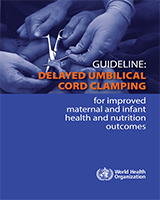The optimal timing of umbilical cord clamping has been debated in the scientific literature for over a century. “Early” cord clamping is generally carried out in the first 60 seconds after birth (generally within the first 15–30 seconds), whereas “delayed” umbilical cord clamping is carried out more than 1 min after the birth or when cord pulsation has ceased (5). In the early 19th century, the English physician, Erasmus Darwin mentioned “another thing very injurious to the child is the tying and cutting of the navel string too soon, which should always be left till the child has not only repeatedly breathed but till all pulsation in the cord ceases. As otherwise the child is much weaker” (6, 7). However, the timing of cord clamping continues to vary according to clinical policy and practice, though surveys of cord clamping practices in a variety of settings and countries indicate that early cord clamping is more frequently practised (8, 9).
There is growing evidence that delayed cord clamping is beneficial and can improve the infant's iron status for up to 6 months after birth. For the first few minutes after birth, there is still circulation from the placenta to the infant. Waiting to clamp the umbilical cord for 2–3 min, or until cord pulsations cease, allows a physiological transfer of placental blood to the infant (the process referred to as “placental transfusion”), the majority of which occurs within 3 min. This placental transfusion provides sufficient iron reserves for the first 6–8 months of life, preventing or delaying the development of iron deficiency until other interventions –such as the use of iron-fortified foods– can be implemented.
Delayed umbilical cord clamping may be particularly relevant for infants living in low-resource settings with less access to iron-rich foods and thus greater risk of anaemia (10). Anaemia, defined as haemoglobin concentration below established cut-off levels (11), is a widespread public health problem with major consequences for human health, affecting and hindering social and economic development. It is estimated that globally 273 million children under 5 years of age were anaemic in 2011, and about 42% of these cases are attributable to iron deficiency (12). Children are particularly vulnerable to iron deficiency anaemia because of their increased iron requirements during periods of rapid growth, especially in the first 2 years of life. Children with iron deficiency are more likely to have delayed psychomotor development, and when they reach school age they are more likely to have impaired performance in tests of language skills, motor skills, and coordination, equivalent to a 5–10-point deficit in intelligence quotient. Both epidemiological and experimental data suggest that when these impairments occur at an early age, they may be irreversible, even after repletion of iron stores, thus reinforcing the importance of approaches (such as delayed cord clamping) that can prevent this condition (13).
The optimal timing of umbilical cord clamping has been previously addressed as part of other perinatal care protocols and guidelines for both the mother and neonate. Postpartum haemorrhage (defined as a blood loss of 500 mL or more within 24 hours after birth) affects approximately 2% of all women who give birth. It is associated with nearly one quarter of all maternal deaths globally, and is also the leading cause of maternal mortality in most low-income countries, as well as a significant contributor to severe maternal morbidity and long-term disability (1). In the past, protocols for the prevention of postpartum haemorrhage (through a package of interventions known as “active management of the third stage of labour”) included early cord clamping. It was believed that early cord clamping led to a reduced risk of postpartum haemorrhage and it was thus practised as part of active management of the third stage of labour (14). However, those protocols have since been revised to recommend delayed umbilical cord clamping (1). Thus, analysis of the timing of umbilical cord clamping in relation to postpartum haemorrhage is considered important.
The timing of umbilical cord clamping is also relevant to neonatal resuscitation practices. About one quarter of all neonatal deaths globally are caused by birth asphyxia, defined simply as the failure to initiate and sustain breathing at birth (15). Effective resuscitation at birth can prevent a large proportion of these deaths. The need for clinical guidelines on basic neonatal resuscitation, suitable for settings with limited resources, is universally recognized and WHO has thus published Guidelines on basic newborn resuscitation (2). In many settings, immediate clamping and cutting of the umbilical cord is needed in order to begin resuscitation protocols for the infant, largely due to the location of resuscitation equipment in the delivery room that requires transfer of the neonate. Whether resuscitation with the cord intact is beneficial is an unanswered question, though recent research has shown that it is a feasible practice, at least in some settings (16).
Immediate and long-term benefits of delayed umbilical cord clamping for infants and mothers, based on the results of randomized controlled trials and other type of studies, are summarized in .
Summary of immediate and long-term benefits of delayed umbilical cord clamping for infants (term, preterm/low birth weight) and mothers from individual studies.
This guideline compiles current WHO recommendations on umbilical cord clamping for maternal and infant health outcomes, in preterm and term births (1, 2).

